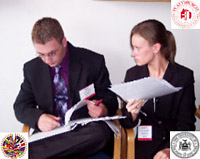Participation in Government Requirement For MOAS at SUNY Plattsburgh
Incorporation of the Model into Participation-in-Government Requirement
 The revised Participation-in-Government (PIG) requirement offers school districts
more leeway in designing the curriculum for the PIG course than was currently in place,
although there seems to have been a rather open-ended practice by the various schools.
The revised Participation-in-Government (PIG) requirement offers school districts
more leeway in designing the curriculum for the PIG course than was currently in place,
although there seems to have been a rather open-ended practice by the various schools.
As it pertains to the NCHS-MOAS, this allows the opportunity for each school to adapt the Model to its particular needs. Over and above the core curriculum (the components of the course in the enclosed sample model) — which prepares the students for the model assembly on the SUNY Plattsburgh campus at the end of the semester and which forms the basis for obtaining college credit — there is additional time to incorporate other materials.
Each high school will be able to take the difference between the college semester requirements (15 weeks, 150 hours per week) and the high school semester (19–20 weeks, 200+ minutes), and provide additional materials tailored to the school’s overall curriculum and/or community. For example, the governmental system of the United States could be compared with the country being represented for the model. Or, various hemispheric issues that the students have studied for the model could be related to the community (ie., immigration, law enforcement, indigenous rights, environmental tourism, economic integration). A comparison of the workings of international law and organization could be made with national law (the United States Constitution vs. the OAS Charter and Declaration of Rights). What does the rule of law mean on a local, national, and international level? Which rights are universal and unalienable and should specialized groups receive different consideration?
Making the Model course one section of the PIG classes will mean that your school will not have to expend additional resources. The participation fee is only $200 per school. The only other direct cost for your school is providing transportation to the campus. Students over and above the maximum of 11 comprising the delegation, several additional students can serve as committee secretaries and newsletter reporters, or they can replace the model assembly unit with a research paper to obtain the college credit. If the class is above 15, two delegations can be sent. So the class size can vary from 10 to 22. For the teacher of the PIG/NCHS-MOAS course, the week-long training session in late June or a day-long session at the high school, if there are less than three teachers to be trained in a given year-will provide the core of the approaches and materials that all teachers in the model will be using. The teacher might very well pick up ideas for additional materials to incorporate. Or the teacher might work in materials from the existing PIG course curriculum in the school. The advantage for each school is the flexibility: building upon the model core and tailoring the course to the teacher’s and school’s particular needs and interests.